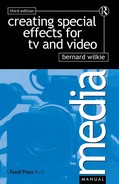Fire Effects in the Studio
A studio ‘conflagration’ is composed more of reflected light and smoke than actual flame – in fact some sequences have been recorded without any flame at all. Nevertheless by using a suitable combination of all three, it is easy to create very dramatic fire scenes. Controlled by switches and gas taps, fire effects of this kind can be turned on and off at will – only the smoke has a lingering persistence.
Because fire scenes are best arranged to favour a single viewpoint it is often necessary to re-dress the scene whenever there is a change of angle. When this is done it is important to recognise the need for smoke continuity.
Use of flame forks
Flame forks (page 88) positioned below the camera can be manipulated to provide a significant amount of flame, particularly when the forks are gently agitated by hand. Unfortunately this ‘frontal flame’ ploy has become something of a cliché and care should be taken when using it.
If flame forks are made from soft copper, they can be bent to adapt to the shape of the set.
Small forks strategically positioned in or around furniture can be used without causing damage, but care should be taken that radiant heat does not scorch the fabric or blister paintwork.
Smoke
Smoke is the most important ingredient in a fire scene because apart from the fact that it would be there anyway, it picks up light from the flames and the flicker effects. It should not be allowed to build up to an extent where it would obscure background effects.
Outdoor sets
Erecting a set outdoors imposes much less restraint; real fires and real destruction can be arranged – with the actors having clear passage to areas of safety.
It is sometimes necessary to clad part of the ceiling to retain the smoke which under the influence of rising heat would otherwise be carried away.
In order to work without limitations, producers commonly make use of empty factories and disused buildings to stage fire scenes.

1. Smoke lit from a lamp shining through a flame drum, a, Flame drum, b, Smoke machine.
2. Indestructible glass fibre curtains used with flame fork.
3. Flame fork behind furniture.
4. Flame fork in front of camera.
5. Flaming ‘furniture shaped’ rig being superimposed over real furniture, using fifty/fifty mirror technique, a, Semi-transparent mirror.
6. Pyrotechnic flare being burnt to provide both light and smoke, a, Sand tray, b, Fireproof sheet (large studios only).
